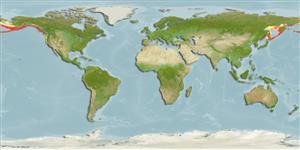Environment: milieu / climate zone / depth range / distribution range
Ecology
Marine; demersal; depth range 0 - 375 m (Ref. 50610). Boreal; 66°N - 38°N
Northwest Pacific: Kamchatka (Ref. 27436) and the Commander Islands, Russia. Northeast Pacific: Aleutian Islands to Nunivak Island, Alaska and San Francisco, California, USA.
Size / Weight / Age
Maturity: Lm ? range ? - ? cm
Max length : 30.5 cm TL male/unsexed; (Ref. 6885)
Dorsal spines (total): 9 - 16; Dorsal soft rays (total): 18 - 20; Anal spines: 1; Anal soft rays: 28 - 29. Caudal moderately forked (Ref. 6885). Light brown on dorsal surface, silvery ventrally, dark along midside, mid-dorsal line in irregular patches, and lateral line; spinous dorsal with dark streaks paralleling free edge; upper parts of pectorals and caudal with darkened edges, and vague dark blotches on rayed dorsal; anal, pelvic fins, and lower parts of pectorals light (Ref. 6885).
Adults are found in deeper waters whereas larvae and juveniles occupy shallow, nearshore habitats (Ref. 57910). Usually buried in muddy or sandy bottoms with mouth protruding (Ref. 2850). Eggs are laid in a gelatinous mass that is attached to rocks (Ref. 2850). Some have been caught by hand in shallow water (Ref. 2850).
Incubation of eggs takes one year (Ref. 57910).
Eschmeyer, W.N., E.S. Herald and H. Hammann, 1983. A field guide to Pacific coast fishes of North America. Boston (MA, USA): Houghton Mifflin Company. xii+336 p. (Ref. 2850)
IUCN Red List Status (Ref. 130435: Version 2024-1)
Threat to humans
Harmless
Human uses
Fisheries: of no interest
Tools
Special reports
Download XML
Internet sources
Estimates based on models
Preferred temperature (Ref.
123201): 1 - 7.6, mean 4.1 °C (based on 434 cells).
Phylogenetic diversity index (Ref.
82804): PD
50 = 1.2500 [Uniqueness, from 0.5 = low to 2.0 = high].
Bayesian length-weight: a=0.00389 (0.00180 - 0.00842), b=3.12 (2.94 - 3.30), in cm total length, based on all LWR estimates for this body shape (Ref.
93245).
Trophic level (Ref.
69278): 4.0 ±0.3 se; based on diet studies.
Resilience (Ref.
120179): Medium, minimum population doubling time 1.4 - 4.4 years (Fec = 1,000).
Fishing Vulnerability (Ref.
59153): Low vulnerability (21 of 100).
Nutrients (Ref.
124155): Calcium = 37.4 [21.5, 86.2] mg/100g; Iron = 0.497 [0.205, 0.989] mg/100g; Protein = 17.3 [15.6, 19.0] %; Omega3 = 0.262 [0.135, 0.511] g/100g; Selenium = 15.3 [6.1, 34.6] μg/100g; VitaminA = 21.2 [4.5, 99.9] μg/100g; Zinc = 0.417 [0.274, 0.627] mg/100g (wet weight); based on
nutrient studies.
